Topics
Category
Era
Great Northern Railway
The Great Northern Railway was a transcontinental railroad system that extended from St. Paul to Seattle. Among the transcontinental railroads, it was the only one that used no public funding and only a few land grants. As the northernmost of these lines, the railroad spurred immigration and the development of lands along the route, especially in Minnesota.
On September 18, 1889, Minnesota entrepreneur James J. Hill created the Great Northern Railway from the bankrupt St. Paul and Pacific and the Minneapolis and St. Cloud. On February 1, 1890, the Great Northern assumed control of his other railroad companies, among them the Montana Central Railway and the St. Paul, Minneapolis and Manitoba.
Hill employed the strategy of purchasing bankrupt companies and revitalizing them until they were profitable. He began at the start of his career by purchasing small shipping companies. After acquiring the St. Paul and Pacific, which had gone bankrupt in the Panic of 1873, Hill expanded the line through trackage rights with the Northern Pacific. It was then renamed the St. Paul, Minneapolis and Manitoba in May of 1879.
Hill expanded his nascent railroad network while upgrading existing lines. He built in stages, creating profitable lines first before undertaking further expansion, thus avoiding excessive debt. His companies sold homesteads to immigrants and furnished the trains by which they would reach their new homes. They solicited further immigration by advertising in European newspapers and hiring overseas agents, who sought out immigrants looking for their own farmland.
The railroad reinvested profits into the company to fuel expansion and improve existing infrastructure. Hill brought in industries and strategically placed them along the network. This pattern continued throughout the 1880s as he expanded his empire over Wisconsin, Minnesota, North Dakota, and Montana. The railroad hauled goods and passengers, encouraged immigration along the route, and helped bring wheat harvests to market at Minneapolis.
The Great Northern was to be a true transcontinental railroad. Beginning in St. Paul and crossing the Mississippi River over the Stone Arch Bridge at Minneapolis, the line extended westward through North Dakota and Montana. The Great Northern built to the north of the Northern Pacific route. It proceeded until the Rocky Mountains, where it used the recently discovered Marias Pass through the continental divide.
The Marias proved to be an easier pass than the one used by the Northern Pacific, as it was the lowest crossing of the Rockies south of Canada. Taking the pass also shortened the overall length of the route. Building continued through Idaho and Washington and reached Seattle in 1893. Unlike other railroads, the Great Northern did not declare bankruptcy. Official completion was at Scenic, Washington, on January 6, 1893.
Along the sparsely populated right of way through Minnesota, North Dakota, and Montana, the Great Northern bought land from the federal government. It rarely, however, resorted to land grants, instead selling parcels to newly arrived immigrants—most from Germany and Scandinavia.
The railroad created special “colonist” or “emigrant” cars—passenger cars appointed in Spartan fashion—to inexpensively convey immigrants to their new farmsteads. The railroad advertised Minnesota land, and many immigrants bought plots reclaimed from swamps. The state granted over two million acres of swampland to aid in railroad construction. Some of the larger grants that became part of the Great Northern included lines from St. Paul to Duluth and from St. Cloud to Hinckley.
Hill purchased large portions of real estate in Minnesota's Mesabi Iron Range in 1898. This included mines and railroad lines. The Great Northern controlled many of the shipments of Minnesota ore to the steel mills of the nation. It obtained renown for its Empire Builder passenger train, which operated service to the west coast by way of Glacier National Park. Despite antitrust proceedings that forced Hill to divest from his other railroad interests, the Great Northern weathered economic downturns and proved to be a profitable railroad for most of the twentieth century.
Ironically, the same railroads that Hill was forced to give up merged with the Great Northern in 1970 to form the Burlington Northern. This network merged with another historic railroad, and a considerable portion of the Great Northern now operates as the BNSF Railway. Amtrak continues to offer service on the Empire Builder passenger train.
Bibliography
Engelhardt, Carroll L. Gateway to the Northern Plains: Railroads and the Birth of Fargo and Moorhead. Minneapolis: University of Minnesota Press, 2007.
Glischinski, Steve. Minnesota Railroads: A Photographic History, 1940–2012. Minneapolis: University of Minnesota Press, 2012.
Haeg, Larry. Harriman vs. Hill: Wall Street’s Great Railroad War. Minneapolis: University of Minnesota Press, 2013.
Hidy, Ralph W. The Great Northern Railway: A History. Minneapolis: University of Minnesota Press, 2004.
Hofsommer, Don L. Minneapolis and the Age of Railways. Minneapolis: University of Minnesota Press, 2005.
Luecke, John. The Great Northern in Minnesota: the Foundations of an Empire. St. Paul: Grenadier Publications, 1997.
Malone, James P. James J. Hill: Empire Builder of the Northwest. Norman, OK: University of Oklahoma Press, 1996.
Martin, Albro. James J. Hill & The Opening of the Northwest. St. Paul: Minnesota Historical Society Press, 1991.
Yenne, Bill. Great Northern Empire Builder. St. Paul: MBI, 2005.
Related Resources
Primary
Condensed History: Great Northern. St. Paul: Great Northern Public Relations Department: 1969.
Great Northern Railway Company (U.S.) corporate records, 1854–1970
Manuscript Collection, Minnesota Historical Society, St. Paul
http://www2.mnhs.org/library/findaids/00901.xml
Description: The corporate records of the St. Paul-based Great Northern Railway, its predecessors, and its subsidiaries and affiliates, document its operations across the northern tier of western states for more than one hundred years.
Hidy, Ralph W., and Muriel E. Hidy. “John Frank Stevens, Great Northern Engineer.” Minnesota History 41, no. 8 (Winter 1969): 345–361.
http://collections.mnhs.org/MNHistoryMagazine/articles/41/v41i08p345-361.pdf
James J. Hill papers, 1823–1925 (bulk 1860–1916)
Manuscript Collection, Minnesota Historical Society, St. Paul
http://www2.mnhs.org/library/findaids/00698.xml
Description: Correspondence, financial records, legal documents, diaries, blueprints, maps, publications, speeches, biographical data, newspaper clippings, and photographs related to the personal and business dealings of St. Paul railroad baron and business magnate James J. Hill.
Whitney, F. I. Valley, Plain and Peak: Scenes on the Line of the Great Northern Railway. St. Paul: Passenger and Ticket Office, 1894.
Secondary
Iseminger, Gordon. "Silk Trains on the Great Northern Railway." Minnesota History 54, no. 1 (Spring 1994): 16–31.
http://collections.mnhs.org/MNHistoryMagazine/articles/54/v54i01p016-031.pdf
Shaw, Douglas. Ralph Budd, the Great Northern Railway, and the Advent of the Motor Bus. Railroad History 166 (Spring 1992): 57–79.
Strom, Claire. Profiting From the Plains: The Great Northern Railway and Corporate Development of the American West. Seattle, WA: University of Washington Press, 2003.
Williams, Susan. “‘A Wild Hurrah’: The Great Northern Celebration of 1893.” Minnesota History 48, no. 3 (Fall 1982): 119–123.
http://collections.mnhs.org/MNHistoryMagazine/articles/48/v48i03p119-123.pdf
Web
Great Northern Railway Historical Society.
https://www.gnrhs.org/index.php
Related Images
This sign was attached to a float in the St. Paul Winter Carnival parade, ca. 1942. The image of the mountain goat was used extensively in advertising and equipment livery by the Great Northern. Mountain goats are plentiful at Glacier National Park, which was a site of great importance in the marketing of Great Northern passenger service. However, its use as a symbol by the Great Northern is said to have originated from former railroad president William Kenney. He employed one in the delivery of newspapers as a boy.
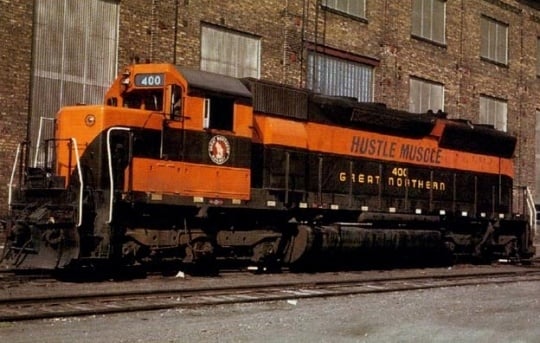
Great Northern diesel locomotive number 400
Great Northern diesel locomotive number 400, 1966. Photograph by Myron T. Gilbertson.
Holding Location
Articles
More Information
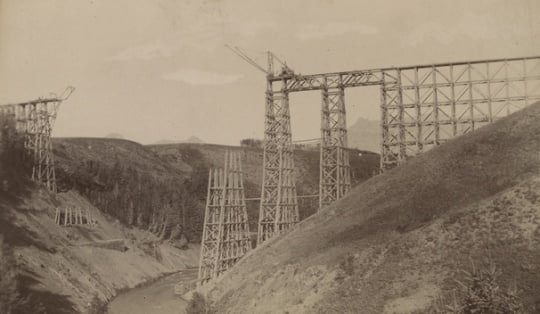
The Great Northern Railway trestle over Two Medicine in course of construction
The Great Northern Railway trestle over Two Medicine in course of construction, ca. 1877.
Public domain
Holding Location
Articles
More Information
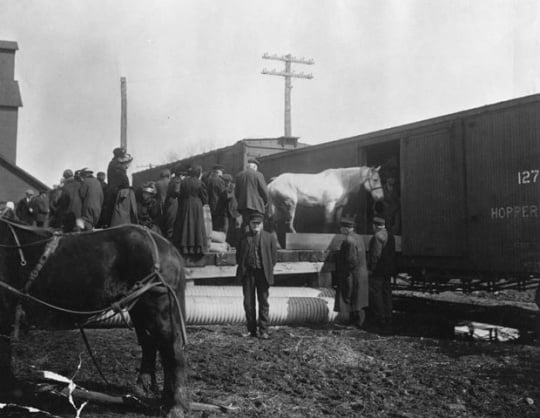
Loading horse and possessions of homesteaders
Loading horse and possessions of homesteaders into Great Northern Railway boxcar, date unknown.
Holding Location
Articles
More Information
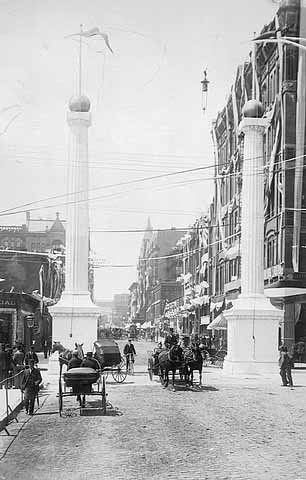
Celebration of the completion of the Great Northern Railway
Celebration on Sixth Street West in St. Paul on the occasion of the completion of the Great Northern Railway, 1893. Photograph by T. W. Ingersoll.
Holding Location
Articles
More Information

Minnesota exhibit of farm product in railway car
Minnesota exhibit of farm product in railway car, Great Northern Railway, Western Governors Special, ca. 1911.
Public domain
Holding Location
Articles
More Information
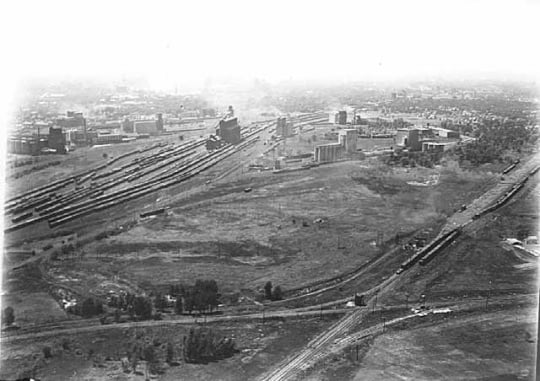
Aerial view showing Great Northern Railway yards in southeast Minneapolis
Aerial view showing Great Northern Railway yards in southeast Minneapolis, ca. 1921. Photograph by Paul W. Hamilton.
Holding Location
Articles
More Information

Construction crew at work on a bridge along the right of way
Construction crew at work on a bridge along the right of way, 1929. Photograph by Briol Studio.
Holding Location
Articles
More Information
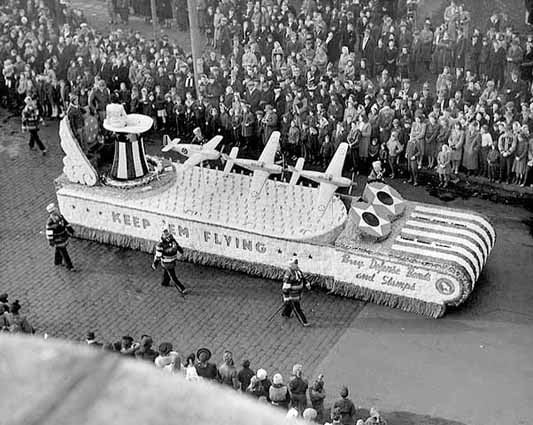
Great Northern Railway float
Great Northern Railway float, St. Paul Winter Carnival, 1942.
Holding Location
Articles
More Information
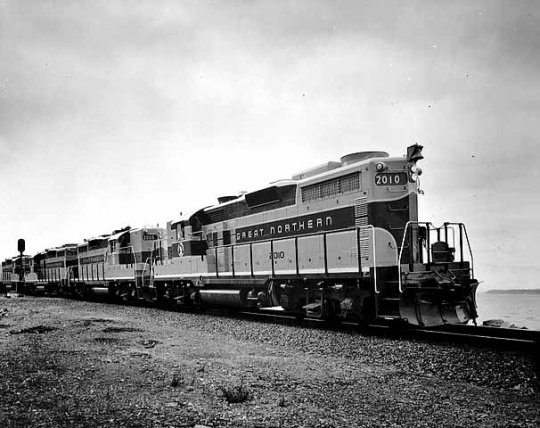
Great Northern Railway diesel locomotives #2010, 2005, and 2012
Great Northern Railway diesel locomotives #2010, 2005, and 2012, ca. 1935–1945. Photograph by Charles R. Pearson Photography.
Holding Location
Articles
More Information
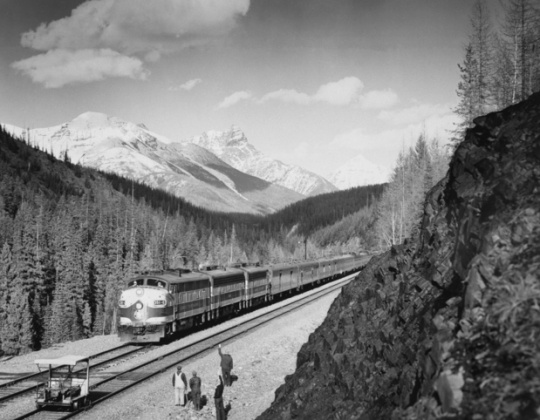
Great Northern streamliner train in Glacier National Park
Great Northern streamliner train in Glacier National Park, ca. 1955. Photograph by the Great Northern Railway.
Holding Location
Articles
More Information

Great Northern Railway’s Winnipeg Limited crossing the Stone Arch Bridge
The Great Northern Railway’s Winnipeg Limited crossing the Stone Arch Bridge, Minneapolis, ca. 1955.
Holding Location
Articles
More Information
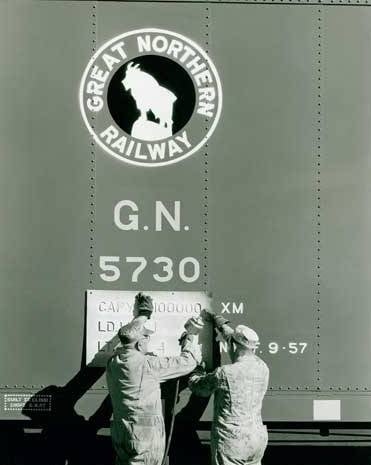
Load capacity figures being stenciled on a Great Northern Railway boxcar
Load capacity figures are stenciled on each boxcar as it comes out of the paint shop at Great Northern Railway's shops in St. Cloud, ca. 1957. Photograph by Henrich-Blessing Studio.
Holding Location
Articles
More Information
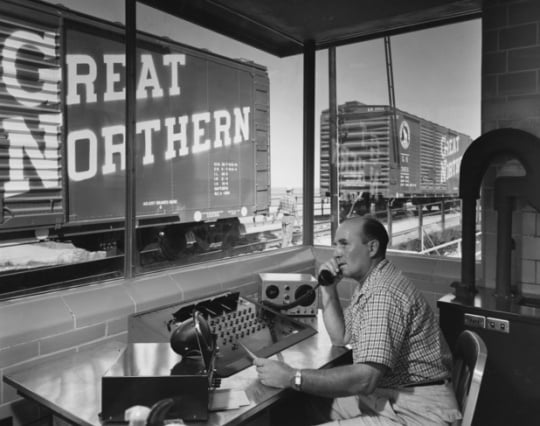
Interior of hump office at Great Northern Railway’s Gavin Yard in Minot, North Dakota
Interior of hump office at Great Northern Railway’s Gavin Yard in Minot, North Dakota, ca. 1958. Photograph by Hedrich-Blessing.
Holding Location
Articles
More Information
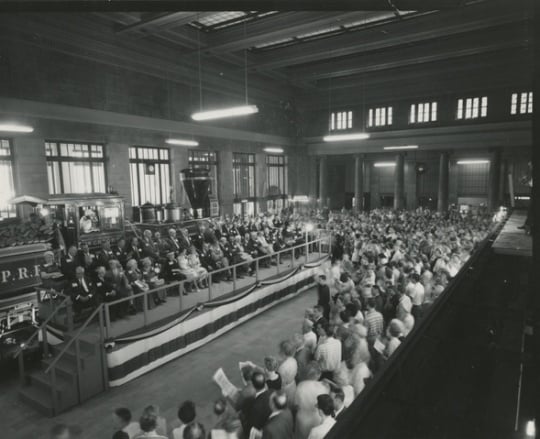
100th anniversary celebration of the Great Northern Railway
Speaker’s stand and crowd at the 100th anniversary celebration of the Great Northern Railway at St. Paul’s Union Depot, 1962.
Holding Location
Articles
More Information
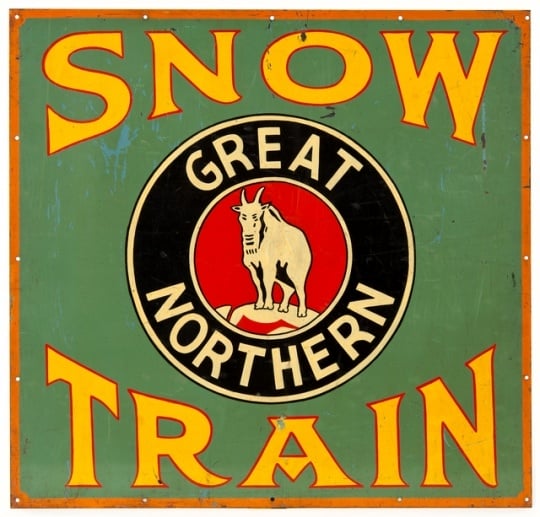
Great Northern Railway "Snow Train" sign
This sign was attached to a float in the St. Paul Winter Carnival parade, ca. 1942. The image of the mountain goat was used extensively in advertising and equipment livery by the Great Northern. Mountain goats are plentiful at Glacier National Park, which was a site of great importance in the marketing of Great Northern passenger service. However, its use as a symbol by the Great Northern is said to have originated from former railroad president William Kenney. He employed one in the delivery of newspapers as a boy.
Holding Location
Articles
More Information
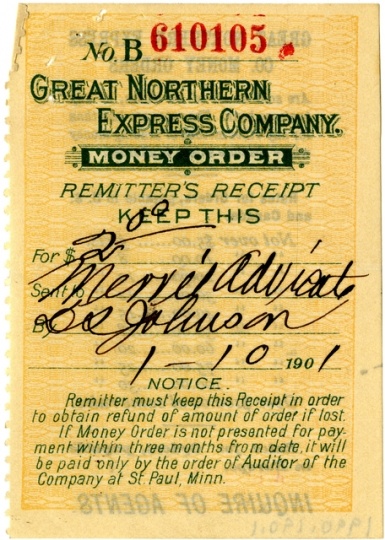
Great Northern Railway Company money order receipt
Great Northern Railway Company money order receipt, 1901.
Related Articles
Turning Point
In 1904, Hill’s Northern Securities Trust, consisting of the Great Northern and his other railroads, is found by the U.S. Supreme Court to be in violation of the Sherman Antitrust Act. Hill begins to manage the railroads of his empire separately.
Chronology
September 16, 1838
1873
May 1879
1883–1889
1889
February 1, 1890
January 6, 1893
April 14, 1894
1896
1898
1901
1904
1970
1996
Bibliography
Engelhardt, Carroll L. Gateway to the Northern Plains: Railroads and the Birth of Fargo and Moorhead. Minneapolis: University of Minnesota Press, 2007.
Glischinski, Steve. Minnesota Railroads: A Photographic History, 1940–2012. Minneapolis: University of Minnesota Press, 2012.
Haeg, Larry. Harriman vs. Hill: Wall Street’s Great Railroad War. Minneapolis: University of Minnesota Press, 2013.
Hidy, Ralph W. The Great Northern Railway: A History. Minneapolis: University of Minnesota Press, 2004.
Hofsommer, Don L. Minneapolis and the Age of Railways. Minneapolis: University of Minnesota Press, 2005.
Luecke, John. The Great Northern in Minnesota: the Foundations of an Empire. St. Paul: Grenadier Publications, 1997.
Malone, James P. James J. Hill: Empire Builder of the Northwest. Norman, OK: University of Oklahoma Press, 1996.
Martin, Albro. James J. Hill & The Opening of the Northwest. St. Paul: Minnesota Historical Society Press, 1991.
Yenne, Bill. Great Northern Empire Builder. St. Paul: MBI, 2005.
Related Resources
Primary
Condensed History: Great Northern. St. Paul: Great Northern Public Relations Department: 1969.
Great Northern Railway Company (U.S.) corporate records, 1854–1970
Manuscript Collection, Minnesota Historical Society, St. Paul
http://www2.mnhs.org/library/findaids/00901.xml
Description: The corporate records of the St. Paul-based Great Northern Railway, its predecessors, and its subsidiaries and affiliates, document its operations across the northern tier of western states for more than one hundred years.
Hidy, Ralph W., and Muriel E. Hidy. “John Frank Stevens, Great Northern Engineer.” Minnesota History 41, no. 8 (Winter 1969): 345–361.
http://collections.mnhs.org/MNHistoryMagazine/articles/41/v41i08p345-361.pdf
James J. Hill papers, 1823–1925 (bulk 1860–1916)
Manuscript Collection, Minnesota Historical Society, St. Paul
http://www2.mnhs.org/library/findaids/00698.xml
Description: Correspondence, financial records, legal documents, diaries, blueprints, maps, publications, speeches, biographical data, newspaper clippings, and photographs related to the personal and business dealings of St. Paul railroad baron and business magnate James J. Hill.
Whitney, F. I. Valley, Plain and Peak: Scenes on the Line of the Great Northern Railway. St. Paul: Passenger and Ticket Office, 1894.
Secondary
Iseminger, Gordon. "Silk Trains on the Great Northern Railway." Minnesota History 54, no. 1 (Spring 1994): 16–31.
http://collections.mnhs.org/MNHistoryMagazine/articles/54/v54i01p016-031.pdf
Shaw, Douglas. Ralph Budd, the Great Northern Railway, and the Advent of the Motor Bus. Railroad History 166 (Spring 1992): 57–79.
Strom, Claire. Profiting From the Plains: The Great Northern Railway and Corporate Development of the American West. Seattle, WA: University of Washington Press, 2003.
Williams, Susan. “‘A Wild Hurrah’: The Great Northern Celebration of 1893.” Minnesota History 48, no. 3 (Fall 1982): 119–123.
http://collections.mnhs.org/MNHistoryMagazine/articles/48/v48i03p119-123.pdf
Web
Great Northern Railway Historical Society.
https://www.gnrhs.org/index.php

















